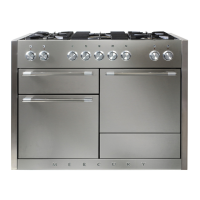INSTALLATION
Check the appliance is electrically safe and gas sound when you have nished.
26
A
600
350
100
250
Fig.7-24
All dimensions in millimetres
Gas Connection
This must be in accordance with the relevant standards.
The exible hose (not supplied with the cooker) must be
in accordance with the relevant standards. Hoses may be
purchased at most builders’ merchants.
The gas supply needs to terminate with a down-facing
bayonet.
The connector is located just below the hotplate level at the
rear of the cooker. If in doubt contact your supplier.
The rear cover boxes limit the position of the supply point.
Because the height of the cooker can be adjusted and
each connection is dierent, it is dicult to give precise
dimensions.
Although a 900 mm hose can be used, a 1250 mm hose
will allow slightly more exibility in the positioning of the
bayonet and make moving the cooker easier.
For Natural Gas, the exible hose must be in accordance with
BS 669. For LP Gas, it should be capable of 50 mbar pressure,
70 °C temperature rise, and carry a red stripe, band or label. If
in doubt contact, your supplier.
The hose should be tted so that both inlet and outlet
connections are vertical so that the hose hangs downwards
in a ‘U’ shape. Ideally the hose supply connection should be
within the shaded area ‘A’ (Fig.7-24).
Screw connect the threaded end of the hose into the gas
inlet.
After completing the gas connection, make sure that the
cooker is gas sound with a pressure test.
Pressure Testing
The gas pressure can be measured at the pressure test point
on the gas connection block.
Connect the pressure gauge. Turn on and light one of the
hotplate burners.
See the data badge for test pressures.
Turn o the burners and remove the pressure gauge.
Check the appliance is gas sound.
Check the operation of all the burners.

